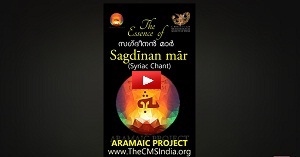
AP 320 to 311
The ESSENCE of SAGDINAN MAR - by Joseph Palackal, CMI
| Call Number | AP 315 |
| Part Number | Part I - Syro Malabar Church |
| Title | The ESSENCE of SAGDINAN MAR - by Joseph Palackal, CMI |
| Duration | 2:03 |
| Place of Recording | Syro Malabar Convention, Houston, USA (2022) |
| Date of Release | 2022 |
| Youtube URL | https://www.youtube.com/watch?v=qIxtJcWWlVM |
| Video Segment (s) |
|
Notes
The Essence of Syriac Chant, SAGDINAN MAR - The Undivided Divinity and Humanity of the Lord, Jesus! by Dr. Joseph J. Palackal, CMI during the invited lecture at the Syro Malabar Convention, Houston, USA (2022)
Sagdīnan mār | സഗ്ദീനൻ മാർ
This is the 18th verse from the hymn, “Brīk hannānā” (“blessed is the merciful one”) from the night prayers (lelya) for Sundays in Advent and Christmas in the East Syriac tradition. The hymn belongs to the category of “Tešbohtā” (“praise”), in praise of the mystery of incarnation. The hymn consists of twenty couplets. Each verse has 4 + 4 = 8 syllables (Sag-dīn-an- mār/ lā-lā-hū-sākh). Because of the theological significance of the text, the breviary prescribes this couplet be sung three times. At some point in the history, definitely before the seventeenth century, the St. Thomas Christians started treating this couplet as a separate hymn. The performance context varied from the beginning of Qurbana on the major feasts of the Lord to the conclusion of festal processions. The usual performance practice is to sing the same text and melody three times in three ascending pitch registers.
The earliest reference to the hymn is in the acrostic hymn in Syriac, written by a Catholic St. Thomas Christian priest, Fr. Chandi Kadavil, popularly known as “Alexander the Indian” (1588- c. 1673). The title of Fr. Kadavil’s acrostic hymn on the Eucharist contains a reference to the opening words of this chant. Fr. Kadavil wrote the acrostic hymn according to meter and melody of “Sagdīnan mār.” It means that the hymn was already popular among the St. Thomas Christians at the dawn of the seventeenth century (i. e., before the Coonan Cross Oath (1653) and the ensuing divisions in the community.
The text is highly Christological and deserves further study. This may very well be the earliest known East Syriac hymn on the subject of hypostatic union and Incarnation. It is, in effect, a paraphrasing of the exuberant acclamation of St. Thomas, the Apostle of India: “Mār walāh,” “My Lord and my God” (Jn 20:28). In those two words, the Apostle acknowledged the humanity and divinity of Christ. In the course of history, the manner of the coexistence of the humanity and divinity in the person of Christ became a topic for heated discussions that shook the foundation of the Christian religion. There is a play on the shades of meaning of the final phrase “lā pūlāga.” It can mean “without doubt,” or “without division.” The alternate translation given above is based on these meanings. The hymn resolves the long-standing Christological controversies (Council of Ephesus and Council of Chalcedon). The special significance the East Syriac Churches in India gave to this hymn is an indication that these Churches were not subject to those controversies. The hymn is a perfect example of the interface of music, poetry, pedagogy, dogma, theology, liturgy, and catechesis. It also represents an era when liturgy was the prime medium for catechesis.
So far, we know of two melodies for this hymn. See one example in Aramaic Project-79. Fr. Thomas Kalayil, CMI sang a different melody during our interview. This video remains to be published. Interestingly, both melodies are different from the traditional melody of Brīk hannānā (see track no. 7 in the CD, “Qambel Maran: Syriac Chants from South India” ). Until further evidence appears, we may presume that these melodies were composed in Kerala.
Joseph J. Palackal CMI
New York
1 June 2018
Keywords : #syriacchants#aramaicproject #syriacchants #SagdinanMar #aramaicproject
Related Videos
- AP 6j - Dr. Jacob Vellian sings the mMelody of "Sagdeenan maar."
- AP 25f - Rev. Fr. Sebastian Sankoorikkal: Melody of “Sagdeenan maar”.
- AP 79 - Sagdinan Mar. A unique Syriac chant
- AP 91 - Bishop Joseph Kallarangatt sings "Sagdīnan mār"
- AP 98 - Dr. Joseph J. Palackal teaches the choir members, the aramaic chant "Sagdinan Mar"
- AP 101 - Sagdīnan mār. at First communion. Northern Virginia
- AP 107e - Fr. Thomas Kalayil, CMI on "Sagdinan mar"
- AP 113 - Dr. Thomas Kalayil, CMI, speaks On "Sagdinan Mar," the Christological hymn
- AP 134 - Sagdinan mar" in Toronto, Canada
- AP 146 - Practice session for bilingual Qurbana at National Convention in Houston, Texas
- AP 179 - Papputty Master (Violin instrumental track)
- AP 196 - Ramsha Mariam Payyappilly sings syriac chant
- AP 243 - Children Group sings at St Jude Syro Malabar Catholic Church
- AP 324 - SAGDINAN MAR. The Christological hymn in the unique voice of Emma Robin, Texas
- AP 326 / AP2-116 - Melody of "Sagdinan" from the Chaldean Syrian church of the East



